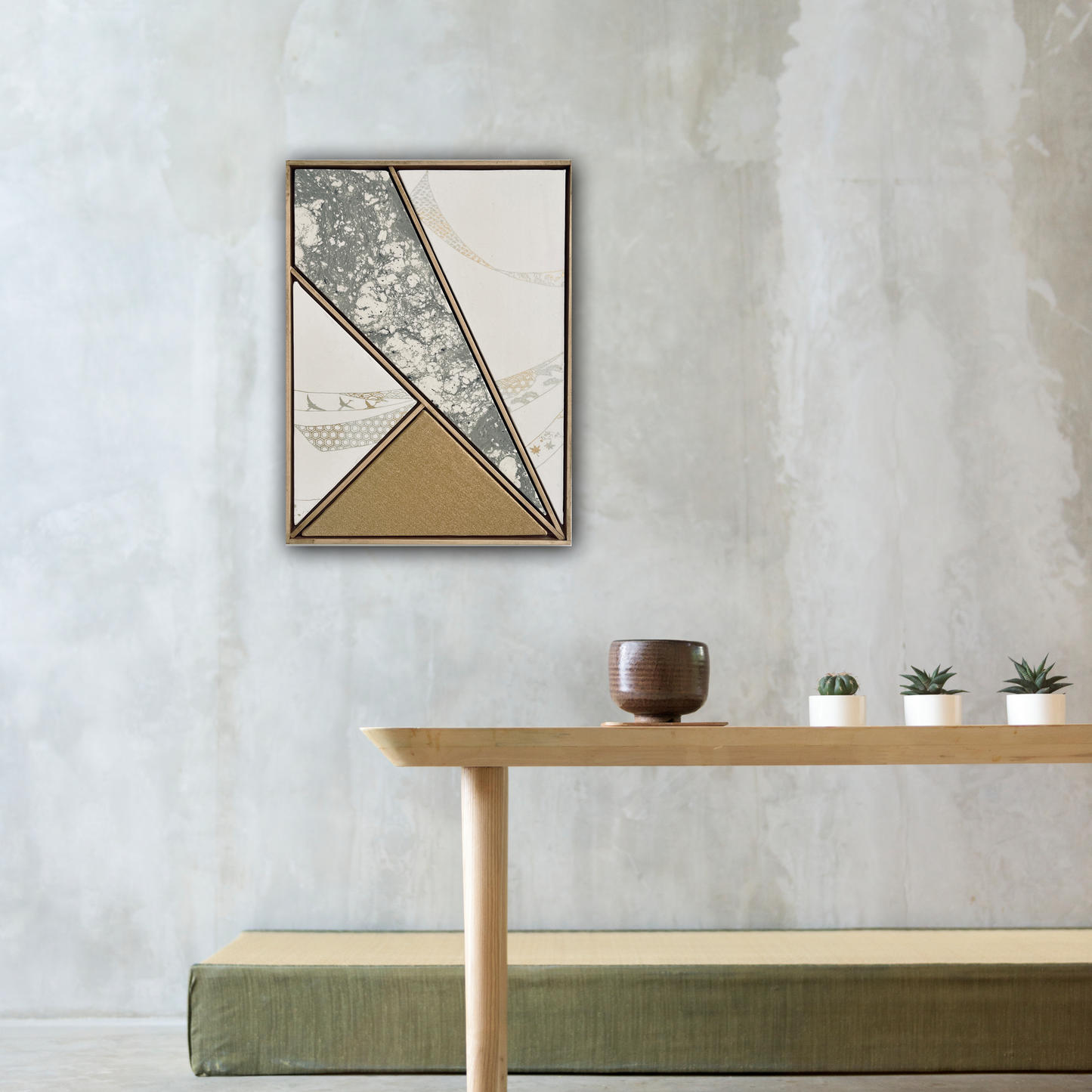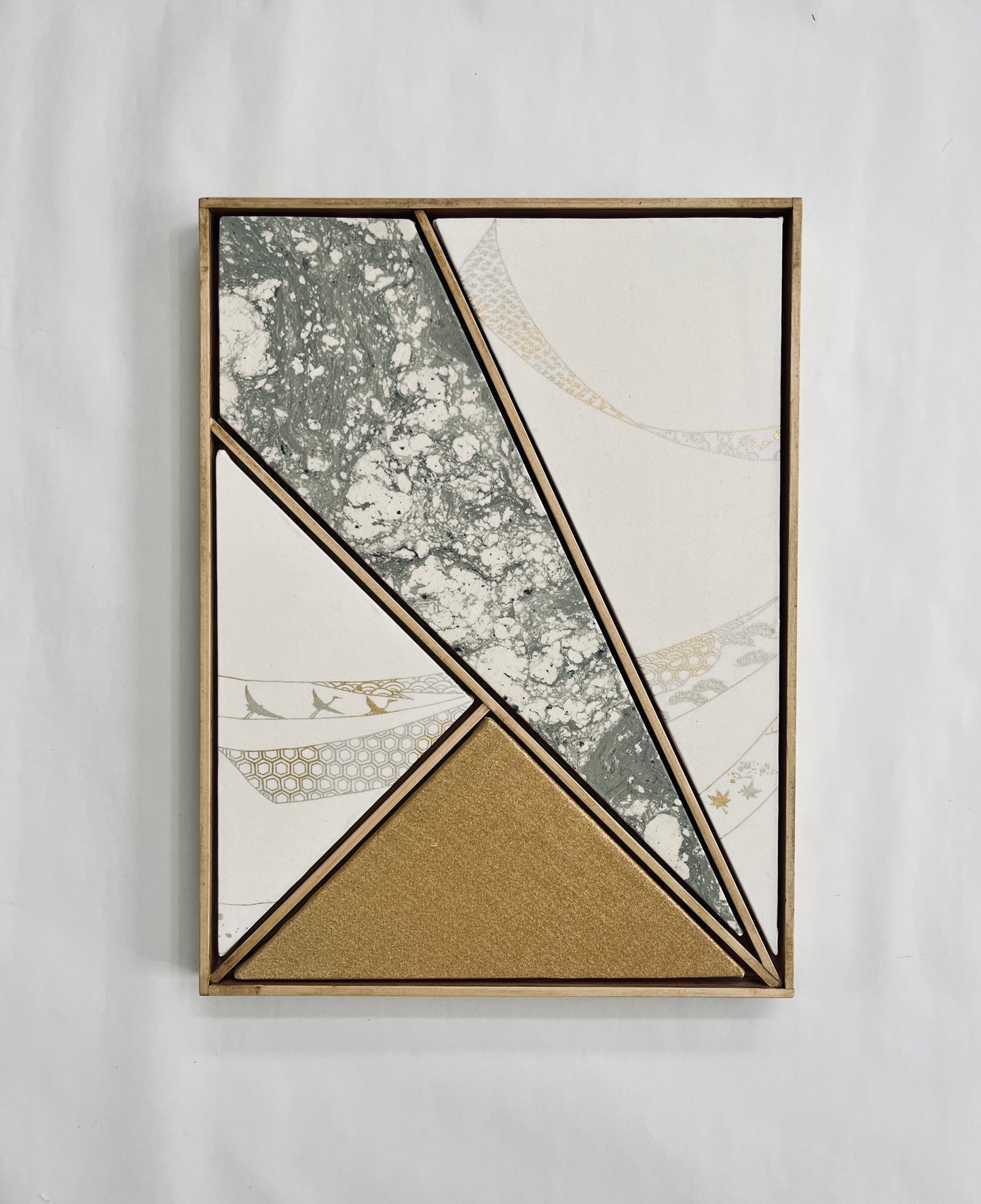Geometry ~Marble~
Geometry ~Marble~
受取状況を読み込めませんでした
Size
30 x 40 x 4cm
Materials
silk (outside-layer) , wooden frame (paulownia)
Story behind the work
This work is inspired by traditional Japanese nature motifs symbolism, and is framed in paulownia wood originally used for a kimono chest-of-drawers.
It is elegantly framed with paulownia wood originally used for kimono chest-of-drawers, and is filled with storytelling and sense of luxury.
I used pieces of kimono that could no longer be used as clothing and kiritansu chest-of-drawers that would normally be discarded to create the ultimate upcycled piece.
Explanation and meaning of pattern and colors
The noshi pattern, often seen on kimono, holds significance rooted in Japanese culture and tradition. The term "noshi" originally referred to a ceremonial cord made from dried abalone or dried strips of dried fish, which was used to tie together gifts or offerings. Over time, the noshi pattern evolved into a decorative motif with its own symbolic meanings. Here are some interpretations of the noshi pattern on kimono:
-
Celebration and Good Wishes: The noshi pattern is often associated with celebrations and well-wishes. It symbolizes joy, congratulations, and good fortune, making it a popular choice for kimono worn during festive occasions such as weddings, graduations, or New Year's celebrations. The pattern conveys sentiments of happiness and auspiciousness, reflecting the positive intentions of the wearer.
-
Symbol of Respect and Appreciation: Historically, noshi were attached to gifts as a symbol of respect and appreciation for the recipient. Similarly, the noshi pattern on kimono can be interpreted as a gesture of respect towards tradition and cultural heritage. It may also symbolize gratitude for life's blessings and the importance of maintaining harmonious relationships with others.
-
Wish for Longevity and Prosperity: In some contexts, the noshi pattern is associated with wishes for longevity and prosperity. The intricate folds and layered appearance of the noshi motif may evoke the image of a tied bundle, symbolizing abundance, security, and continuity. By wearing the noshi pattern, individuals may express their hopes for a long, prosperous, and fulfilling life.
-
Elegant Aesthetic: Beyond its symbolic meanings, the noshi pattern is valued for its aesthetic appeal and decorative qualities. The geometric arrangement of overlapping rectangles or diamond shapes creates a visually striking design that adds depth and texture to the fabric of the kimono. Whether woven, embroidered, or printed, the noshi pattern enhances the overall beauty and elegance of the garment.
Overall, the noshi pattern on kimono carries multifaceted meanings, encompassing themes of celebration, respect, good fortune, longevity, and aesthetic appreciation. It serves as a cultural emblem that honors tradition while also expressing personal sentiments and aspirations.
Characteristics of the fabric
Marble pattern fabric and white fabric with noshi pattern is taken from kimono, golden one - from an obi belt.
About the frame
Kiritansu - chest-of-drawers for kimono, is traditionally made from paulownia wood, a uniquely Japanese material closely tied to the world of kimonos.
Paulownia wood is known as the lightest wood in Japan, prased for its natural luster, resistance to moisture, and resilience against cracking. Since ancient times, it has been used in crafting furniture, chests, and musical instruments.
During the Edo period, it became customary to store cherished kimonos in paulownia chests, which offered fire resistance and protection from moisture and insects.
Traditionally, when a daughter was born, a paulownia tree would be planted. Upon her marriage, the tree would be cut down, and the wood would be used to craft a chest for her as a wedding gift.
Following the Ansei Earthquake during the late Edo period in 1855, paulownia chests gained popularity due to their ability to withstand fires and even float in water, thereby safeguarding their contents during floods.
I use antique kiritansu that can’t be used as furniture anymore to create basis and frames for my works. It adds them even more authentic atmosphere of traditional wabisabi spirit. Can you feel it?
Decoration Advice
Canvas can be displayed on a table, wall, etc. Hanging on a wall requires hooks, tacks or nails. It can also be displayed propped up on an easel. Ideal for a room makeover, housewarming gift, present, or souvenir for a loved one.
Precaution
All the works are made from real kimonos, antiques and vintages. For this reason, the fabric may have traces of long-term use and minor fabric damages. In case there are any scratches or stains, we always add a photo of the area on the item page, so please check before purchasing. Regarding precaution, cancellation and refund policy, please refer to the refund policy in the footer section of the site for information.




